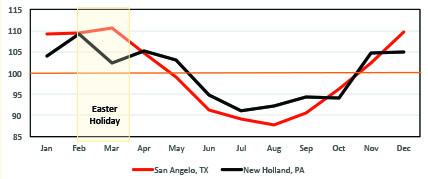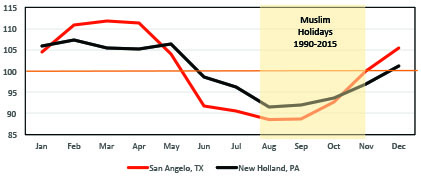Meat Goat Marketing and Price Seasonality
Background
A successful meat goat enterprise depends on successful meat goat marketing. For meat goat producers with goat kids to sell, a key component of marketing success is knowledge of market dynamics and how those dynamics influence your operation’s marketing plan. Seasonality in prices, i.e. the typical price pattern within a year, is one component of price dynamics that meat goat producers should consider.
Meat goat producers must answer three questions related to marketing their product, including: (1) what, (2) where, and (3) when. A greater understanding of price seasonality can help the individual producer address both the “What” and the “When” of meat goat marketing.
Seasonality
As with any biological production process, meat goat prices are influenced by the natural production cycle. That is, the typical price pattern during a year reflects that biology drives breeding and kidding schedules for most meat goat operations. Prices are generally higher in the spring when fewer kids are available before the bulk of kidding season. In a typical year, the price peaks are pro-gressively later by weight category, reflecting the additional time needed to grow kids to heavier weights. Figure 1 illustrates the sea-sonal price pattern for San Angelo, TX for the three primary weight categories for commercial meat goats.
Note: Prices are calculated as percent of the annual average price. Prices generally begin to decline after the kidding season. They typically hit the low point somewhere in mid-summer or early fall, depending on the weight category and as more goats are available on the market.
Figure 1. Meat goat seasonal price chart by weight category (San Angelo, TX).
Differences in Seasonal Patterns Across Markets
Seasonal price patterns may differ not only across weight categories, but also across geographical locations. Figures 2 and 3 illustrate differences in seasonal patterns across two USDA reported goat market auctions in the U.S. for two major weight categories. San Angelo, TX and New Holland, PA are considered to be two primary markets in the U.S. goat market. Note that although both markets have the same general pattern of higher prices in the early spring followed by declining prices to seasonal lows around Au-gust, the magnitude of the seasonal price swings is different. In San Angelo, the high prices in the spring are typically greater than 10% of the annual average, but in New Holland the high prices barely reach above 5% above the annual average. In New Holland the seasonal price difference?? seems to be steadier and last longer than in San Angelo.
Prices are not only determined by supply factors, as discussed previously. Demand factors influence the market price as well. However, much of the market information on the demand side of the meat goat market is more difficult to document. There are sev-eral ethnic holidays in the U.S. that potentially influence the demand for meat goats.
Table 1 lists many of these holidays that represent opportunities for meat goat producers to market specific types of goats in the market place. Since many of these holidays move as much as three weeks from year to year, producers who want to target specific holiday markets will need to track these days as they plan breeding and kidding seasons. Even when some of these holidays occur during a period of seasonally lower prices, prices tend to increase for the period two to three weeks ahead of the holiday.
While an individual year’s price pattern may vary from the typical seasonal pattern, the seasonal price index provides insight into long term “normal” price patterns. Knowledge of seasonal price patterns can be utilized to enhance producer marketing strategies, sometimes by adjusting production patterns. For some producers, it may be feasible to shift the timing of production in order to mar-ket kids of specific weights during periods where prices are seasonally higher. Other producers may choose to focus on having suffi-cient quantity to market animals during periods of high demand, regardless of the seasonal price level. While an individual producer cannot impact or control price, the timing of marketing decisions can make an impact on your bottom line.
Figure 2. Seasonal price chart for two major goat markets; San Angelo, TX and New Holland, PA (20- to 40-pound goats).
Figure 3. Seasonal price chart for two major goat markets; San Angelo, TX and New Holland, PA (40- to 60-pound goats).
Table 1. Various Holidays and Celebrations Where Goat is Typically Served.
| Holiday | Date | Size of Kid | Comments |
|---|---|---|---|
| Easter (Western) | Late March/Early April | 20 to 50 pounds | Date varies |
| Easter (Eastern & Greek) | Mid to Late April | 20 to 50 pounds | Date varies |
| Cinco de Mayo (Hispanic) | May 5 | 20 to 35 pounds | |
| Independence Day | July 4 | 20 to 35 pounds | |
| Caribbean Holidays | August | 60 pounds | Bucks only |
| Start of Ramadan (Muslim) | Based on lunar calendar, changes each year | 45 to 120 pounds | Less than 12 months old |
| Eid al Fitr (Muslim) | Based on lunar calendar, changes each year | 45 to 120 pounds | 60 pounds optimum |
| Eid al Adha (Muslim) | Based on lunar calendar, | Yearlings, blemish free | |
| Dassai (Hindu) | Late September/Mid-October | Male goats only: size varies |
For more information about ethnic holiday dates visit http://www.sheepandgoat.com/articles/ethniccalendar.html
This material is based upon work supported by USDA/CSREES under Award Number 2008 REM-DF-10624





